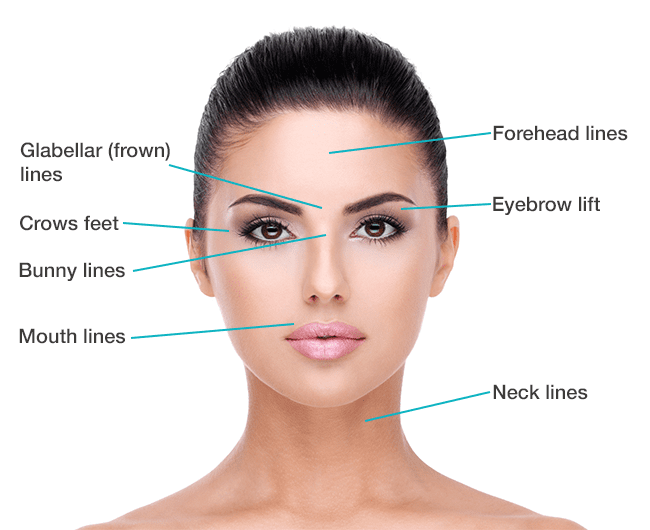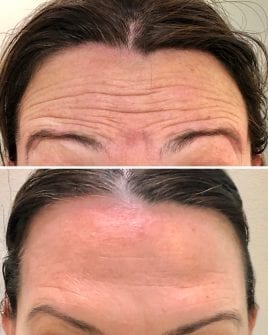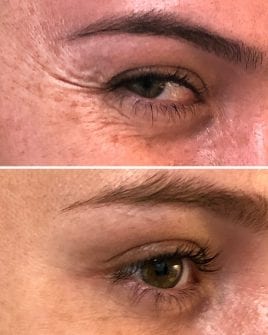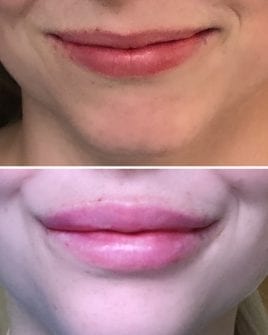Our Facial Aesthetics Offers
Free Facial Cosmetic Injectables Consultation
Free consultation to discuss if facial cosmetic injections are the right treatment option for you, including cost estimates.
Free
Cosmetic Anti-Wrinkle Injections
Anti-Wrinkle injections for frown lines, crow's feet and forehead lines.
$450 for 3 areas
Cosmetic Lip Enhancement Injections
Create a more defined smile with fuller, softer, smoother lips.
$550
Anti-Wrinkle Injections + Teeth Whitening
Package offer
3 injection areas: Frown lines, crow's feet and forehead lines
Philips Zoom! Whitening can lighten the colour of your teeth by up to eight shades.
$890
Lip Enhancement Injections + Teeth Whitening
Package offer
Create a more defined smile with fuller, softer, smoother lips.
Philips Zoom! Whitening can lighten the colour of your teeth by up to eight shades.
$995
Anti-Wrinkle Injections + Lip Enhancement Injections + Teeth Whitening
Package offer
3 injection areas: Frown lines, crow's feet and forehead lines
Create a more defined smile with fuller, softer, smoother lips.
Philips Zoom! Whitening can lighten the colour of your teeth by up to eight shades.
$1,275
Free Facial Cosmetic Injectables Consultation
Free
Cosmetic Anti-Wrinkle Injections
$450 for 3 areas
Cosmetic Lip Enhancement Injections
$550
Anti-Wrinkle Injections + Teeth Whitening
Package offer
$890
Lip Enhancement Injections + Teeth Whitening
Package offer
$995
Anti-Wrinkle Injections + Lip Enhancement Injections + Teeth Whitening
Package offer
$1,275
General information
Cosmetic injectables can be effectively used to treat a number of dental conditions.
Beyond the traditional dental applications, we also offer anti-wrinkle and lip enhancement injections for a complete cosmetic solution to frame your smile.
Our experienced and qualified dentist Dr Elizabeth Kerr has undergone further specific training in aesthetic dentistry to provide facial rejuvenation treatments to our patients. Dr Kerr has been providing these services for a number of years, and has been practising high quality cosmetic and restorative dentistry for over 30 years.
Dr Kerr has a comprehensive knowledge of your oral and facial anatomy, with the expertise needed to deliver effective anaesthesia in a professional clinical environment.
The benefits of choosing a qualified dentist for facial aesthetics procedures:
Owing to superior knowledge of facial anatomy; daily practical experience dealing with the functional and aesthetic aspects of the muscles of the face; and an ability to provide accurate and comfortable injections; Dentists are the most qualified people to be providing facial injections (after attending training courses)” – Australasian Academy of Dento-Facial Aesthetics (AADFA)1.
A qualified dentist has extensive training in the oral and maxillofacial areas (this means the whole face from chin to forehead, extending ear-to-ear) as well as cosmetic dentistry procedures.
Their expertise and capabilities include:
- Relevant technical knowledge of the oral and facial anatomy which includes the underlying muscles, nerves, vascular system and skeletal system surrounding the face.
- A thorough understanding of facial structure and facial aesthetics, including ideal facial proportion and symmetry.
- Highly competent in administering injections.
- Possess a high level of dexterity when performing treatments.
Dentists also have the training, supplies and equipment to deliver effective anaesthesia prior to your treatment being performed.
In addition, having treatment completed in our state-of-the-art surgical practice provides you with a professional and sterile clinical environment.
Dr Elizabeth Kerr’s training:
Dr Kerr completed her training through, and is a certified member of, the respected Australasian Academy of Dento-Facial Aesthetics (AADFA).
AADFA is the first, best and most respected organisation of its kind in Australasia
AADFA prides itself on being a world leader in the field of Complete Dento-Facial Rejuvenation training and the only organisation in Australasia dedicated to upholding professional standards in this regard.
Training is delivered by world-class aesthetic dentistry educators who have years of clinical experience in providing these procedures to patients in practice, and have developed and teach the Facial Aesthetics Module for the Kings College London, Masters of Aesthetic Dentistry Program.
Any procedure being adopted by health professionals requires thorough, up-to-date training at an international level as the foundation to developing clinical competency and a safe and effective practice.2,3

What are muscle relaxant injections?
Muscle relaxant injections, also called anti-wrinkle injections, are made from a purified natural protein.
This minimally invasive treatment is administered through the skin to the underlying muscles of the face.
The treatment works by temporarily blocking the signal between the nerve and the targeted muscle (the nerve impulses of muscles). This releases tension in the specific area and can prevent the muscle from contracting, or reduce the strength of muscular contractions.
Muscle relaxant injections have both dental and cosmetic applications.
In dental application they can be used in the temporomandibular joint (TMJ) to treat pain from TMJ disorder or to help prevent night grinding, by relaxing over-active muscles. They can also be used to relax the muscles in the upper lip to treat excessive gingival display (a ‘gummy smile’) to create a more even and aesthetic smile.
In cosmetic application they can be used to soften and smooth facial lines and wrinkles. Over years of repetitive and sometimes hyperactive contraction, facial muscles cause wrinkles in the overlying skin. By relaxing the muscles, lines and wrinkles can be reduced or eliminated. Areas that can be treated include the forehead, between the eyebrows, sides of the nose, around the eyes, around the lips and the neck.
What are dermal fillers?
Dermal fillers are minimally invasive, temporary cosmetic injectables.
They add volume to the treatment area, and provide immediate structural support and improved skin conditioning.
Our dermal fillers contain hyaluronic acid (HA) which is a type of complex sugar (polysaccharide) that is naturally present in body tissues such as the skin and cartilage. HA is an essential component of skin tissue that provides the skin with moisture, volume and elasticity.
As we age, the levels of naturally occurring HA are depleted, which can result in a loss of volume and skin support, creating grooves, lines and sagging across the face.
Dermal fillers are administered into the dermis of the skin via a small injection. The fillers are in the form of a concentrated gel, which is able to combine with water and swell to provide a filling and smoothing effect. Once injected, the HA gel acts like a sponge to attract water into the skin which results in the area being ‘plumped’ up.
The treatment works by replenishing the areas where natural HA has diminished, restoring volume to the area and smoothing out lines and grooves.
The HA gel is biocompatible meaning it is completely absorbed by your body in a natural process. It is hypo-allergenic and does not contain any harmful chemicals.
Research shows that HA injections also boost the skin’s own production of collagen4.
Dermal fillers have both dental and cosmetic applications.
In dental application they can be administered into lip and gum tissue to address aesthetic concerns such as asymmetrical lips, or to fill papillary deficiencies (gaps between gums and teeth).
In cosmetic application they can be used to add volume to thin or poorly defined lips to make them fuller and smoother, and to prevent lipstick bleeding. They can also treat nasolabial folds (laugh lines), vertical lines (smoker’s lines), a reverse lip line (‘mouth frown’), and poorly defined cheek or chin areas.
Dental procedures
Cosmetic injectables can be used to treat some dental conditions.
The most commonly treated conditions are:
- Gummy smile (excessive gingival display).
- Papillary deficiencies (gaps between gum tissue and teeth).
- Teeth grinding (bruxism).
- TMJ-D (temporomandibular joint disorder).
Gummy smile (excessive gingival display):
A gummy smile, technically known as ‘excessive gingival display’, is when too much gum tissue shows above the top front teeth when you smile.
If this is caused due to a hyperactive upper lip, muscle relaxant injections are a treatment consideration.
In the case of a hyperactive upper lip, the lip may be of normal/average length when resting, but when smiling the muscles that control the skin beneath the nose raise the lip up too far, exposing more of the gums. Some patients with a hyperactive upper lip are also unable to close their mouth completely.
The muscle relaxant injections are administered in the upper lip to reduce the strength of muscular contractions, and therefore preventing the lip from rising up too far when smiling.
The injections will not affect the patient’s ability to chew or speak.
The aim of this treatment is to improve the overall proportion and balance of the smile.
Papillary deficiencies (gaps between gum tissue and teeth):

Dermal fillers can be used to treat and correct dark spaces between the gum line and natural teeth, dental implants, crowns or bridges.
The treatment will have a ‘plumping’ effect on the gum tissue, allowing it to fill in the space.
Note this image is for explanatory purposes only. It is not a before-and-after image of an actual patient.
Teeth grinding (bruxism):
Muscle relaxant injections can be used as a treatment for bruxism.
Bruxism (commonly referred to as teeth grinding) is characterised by involuntary clenching, grinding, grating and gnashing of the teeth. Bruxism is a parafunctional habit, which is the habitual exercise of a body part in a way that is different to the most common use of that body part.
Bruxism is caused by excessive activation of the masseter muscle. Consequences can include damaged tooth surfaces, sensitive teeth, jaw pain, headaches and migraines.
Although muscle relaxant injections are not a cure for bruxism, they may effectively control the symptoms by blocking the nerve endings connected to muscle fibres.
The treatment is injected directly into the masseter muscles (the large muscles that move the jaw) on each side of the face. This relaxes the muscles and may either eliminate the grinding and clenching, or reduce the frequency and force of the habit. It will also provide relief from jaw pain, headaches and migraines.
Voluntary movements, such as chewing and facial expressions, will not be affected by the treatment.
TMJ-D (Temporomandibular joint disorder):
Muscle relaxant injections can be used as a treatment for TMJ disorder.
The temporomandibular joint (TMJ) is located at the base of the skull. It acts as a sliding hinge connecting the mandible (lower jaw) to the temporal bone (the side of the skull). There is one joint located on each side of the jaw. The TMJ allows for the moment required for chewing and talking.
Temporomandibular joint disorder (TMJ-D), also called TMJ dysfunction, affects the jaw joint, muscles and nerves. It can be caused by a range of factors and commonly results in mild to chronic jaw joint pain, jaw muscle tension, jaw muscle pain and facial pain.
Muscle relaxant injections can provide relief from the pain caused by TMJ disorder. The treatment is injected into the masseter muscles (the large muscles that move the jaw) and temporalis muscles (two of the main chewing muscles, located in the temple area) on each side of the face. The treatment helps relax the muscles and reduce the strength of muscular contractions, by blocking the nerve endings connected to muscle fibres.
Causes of TMJ disorder include:
- Bruxism (teeth grinding).
- Teeth or jaw injury.
- Misalignment of the teeth or jaw.
- Poor posture.
- Arthritis.
- Gum chewing.
- Environmental factors (for example playing a musical instrument such as a violin).
- Stress.
Symptoms of TMJ disorder include:
- Jaw muscle spasms and tension.
- Pain or tenderness in the jaw joint, jaw muscle and face.
- Impairment of jaw movement i.e. unable to open or close the mouth fully.
- Pain when chewing.
- Tension headaches, migraines and earaches.
- A clicking sound or grating sensation when opening the mouth or chewing.
Facial aesthetics procedures
Facial aesthetics is the branch of dentistry that focuses on the relationship between your smile and face.
It is a step beyond traditional dental services that allows us to provide our patients with a complete cosmetic solution, to perfectly balance and frame your smile.
As we age, there is a decrease in the body’s natural production of collagen, hyaluronic acid and elastin, which are substances that provide essential structural support, elasticity and volume to the skin. In addition, the muscles on and around the face may weaken, and body fat, including facial deposits, may also redistribute.
These age-related changes can cause wrinkles, lines, folds and grooves to form around the facial muscles. The most common areas for this to occur are around the muscles we use most, including around the eyes, forehead and mouth. Each time a facial muscle is used to form a movement or expression, a groove forms beneath the surface of the skin. As the skin ages and loses flexibility, it is no longer able to spring back in place as effectively and these grooves can become permanently etched into the skin tissue.
Certain areas of the face can also lose the fullness they once had, skin health (condition) may deteriorate, and the skin can develop a ‘sagging’ or sunken appearance. Lips can also lose volume, becoming thinner and less defined.
Additional factors such as smoking, prolonged sun exposure, and stress can also contribute to this process.
During our facial rejuvenation procedures our aim is to help you improve and restore your natural appearance. The treatments are designed to produce a relaxed, youthful and natural result, without looking obvious. We provide both anti-wrinkle injections and dermal fillers.
Interested in facial aesthetics procedures? Book a FREE consultation
If you are interested in facial rejuvenation procedures, we offer free consultations with our qualified dental practitioner Dr Elizabeth Kerr to see if this treatment could be suitable for you.

This consultation will allow you to meet with Dr Kerr and ask her any questions you have.
Dr Kerr will provide you with general advice, as well as discussing your desires and explaining what can be expected from the procedures.
Our aim is for you to feel informed about your options, have realistic expectations of the results, feel confident in Dr Kerr’s experience and knowledge, and feel comfortable in our care before any treatment is decided.
However, there is no obligation or expectation for you to on-book or continue treatment.
Anti-wrinkle treatments (muscle relaxant injections)
Anti-wrinkle injections, also called muscle relaxant injections, are made from a purified natural protein.
They can be used to treat lines and wrinkles that are caused by overactive muscles.
The treatment is administered through the skin to the underlying muscles of the face in specific, targeted areas.
The treatment temporarily relaxes the muscles, which can instantly smooth and soften facial lines and wrinkles. It can also prevent further lines from forming, and prevent the deepening of existing wrinkles when the treatment is maintained.
The treatment works by temporarily blocking the signal between the nerve and the targeted muscle. This releases tension in the specific area and can prevent the muscle from contracting, or reduce the strength of muscular contractions.
The result is a more relaxed, youthful and refreshed appearance in the treatment areas.
Areas that can be treated include:
- Forehead lines
- Crow’s feet
- Glabellar (frown) lines
- Bunny lines (top middle section of the nose)
- Eyebrow lift
- Lines around the mouth
- Neck lines (‘banding’)

Dermal fillers
Dermal fillers are a temporary cosmetic injectable treatment.
They can be used to treat lines and wrinkles that are caused by a loss of collagen and elasticity in the skin. These areas are mostly found on the bottom of your face, from below your eyes to beneath your chin.
Dermal fillers can also be used to enhance and plump the lips.
Our dermal fillers contain hyaluronic acid (HA) which is a type of complex sugar (polysaccharide) that is naturally present in skin tissue. HA is an essential component of skin tissue that provides the skin with moisture, volume and elasticity.
The filler treatment is administered into the dermis of the skin via a small injection. The treatment adds volume to the area, and provides immediate structural support and improved skin conditioning for a rejuvenated appearance.
The filler is in the form of a concentrated gel, which is able to combine with water and swell to provide a filling, plumping and smoothing effect.
Lip enhancement (plumping) injections:
Dermal fillers can be used to create more defined, fuller and smoother lips, as well as to change the shape and size of the lips.
Lip enhancement can add volume to thin or poorly defined lips, and prevent lipstick bleeding.
Areas that can be treated with dermal fillers include:
- Tear troughs
- Poorly defined lips
- Thin lips
- Vertical lip lines (smoker’s lines)
- Marionette lines (lines from lips to chin)
- Nasolabial folds (laugh lines: lines from nose to lips)
- Reverse lip line (downward smile line)
- Mental crease (chin)
- Lack of cheek or chin definition

Facial Aesthetics Before and After Gallery
Please note, any surgical or invasive procedure carries risks. Before proceeding you should obtain personal advice from an appropriately qualified health practitioner. Whilst these are before-and-after images of actual patients, individual results may vary.
References
- AADFA website – 2019 (https://aadfa.net/about/dentists-facial-aesthetics/muscle-relaxant/)
- Bite Magazine / Continuing Education The Innovators in Aesthetic & Facial Rejuvenation Dentistry – 2019 (https://bitemagazine.com.au/the-innovators-in-aesthetic-facial-rejuvenation-dentistry/)
- AADFA website – 2019 (https://aadfa.net/education/)
- In Vivo Stimulation of De Novo Collagen Production Caused by Cross-linked Hyaluronic Acid Dermal Filler Injections in Photodamaged Human Skin – JAMA Dermatology (2007).








